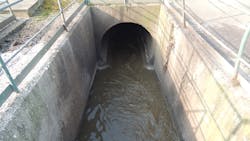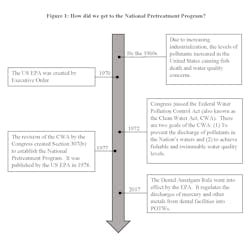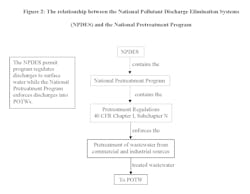What is the National Pretreatment Program?
The National Pretreatment Program is a cooperative effort by the federal, state, and local regulatory agencies to protect the infrastructure of publicly owned treatment works (POTWs) from toxic pollutants discharged by industrial and non-domestic sources. This is done by enforcing the pretreatment of these pollutants. The pretreatment reduces, eliminates, or alters the pollutant’s properties to protect POTWs.
Pollutants, especially from industrial discharges, could contain chemicals causing corrosion to a POTW’s infrastructure, emit hazardous fumes causing safety and environmental risks, interfere with the operations of the wastewater facilities causing greater challenges with sludge disposal, and could also cause the pass-through of toxic discharges to surface water.
The spontaneity of these scenarios create management challenges and greater financial burdens on POTWs for the treatment of wastewater to meet local, state, and federal standards. The National Pretreatment Program aims to prevent these scenarios.
Regulations for the National Pretreatment Program
The National Pretreatment Program was published by the U.S. EPA in 1978 after Congress revised the Clean Water Act (CWA) to address the discharges from industries to POTWs (Figure 1). It is related to the National Pollutant Discharge Elimination System (NPDES), Figure 2.The regulations for the National Pretreatment Program are found in 40 CFR Chapter I (Environmental Protection Agency) Subchapter N (Effluents Guidelines and Standards). It covers definitions, pretreatment standards for existing and new sources of pollution, and a list of point source categories.
What are pretreatment standards?
Pretreatment standards are specific prohibitions or limits on pollutants to protect POTWs. Prohibited pollutants include petroleum oil, those that are fire or explosion hazards, cause corrosive damage, produce heat and could cause interference with a POTW, and those that produce toxic fumes (40 CFR § 403.5).
What are POTWs?
A POTW means treatment works, defined in section 112(5) of the Clean Water Act, owned by a municipality or a state (40 CFR Part 260). It includes intercepting sewers, sewer collection systems, pumps, and other facilities to treat wastewater generated by industry, commercial, and domestic sources.
POTWs could be existing POTWs (constructed before December 1, 1998), new POTWs (constructed after December 1, 1998), Group 1 POTWs (treat waste streams regulated by the National Emission Standards for Hazardous Wastes) or Group 2 POTWs (those that do not meet the definition of Group 1 POTWs).
POTWs should not be confused with federally owned treatment works (FOTWs) described in section 3023 of the Solid Waste Disposal Act. While the terminologies could be confusing, they have different ownerships, different regulatory standards, and some wastes cannot pass through both.
A POTW is also not to be confused with a private onsite wastewater treatment system (POWTS), which is a different regulatory program for onsite wastewater treatment and recycling systems.
The POTW in Toledo, Oregon is an example to understand a POTW. It includes five sewer lift stations, approximately 113,000 linear feet of sewer collection pipes, force main pipes of 7,600 linear feet, 575 utility maintenance holes, and an upgraded treatment plant that treats wastewater from homes, schools, businesses and factories.
What is the purpose of a pretreatment program?
The main purpose of a pretreatment program, according to 40 CFR § 403.2, is to prevent the discharge of pollutants into POTWs, specifically pollutants that could interfere with the operations of a POTW or could cause hazards at the POTW.
Another purpose of a pretreatment program is to improve the opportunities to recycle and reclaim municipal and industrial wastewater sludges. Recycling and reclamation are forms of pollution prevention (known as P2) and addressed in the Pollution Prevention Act of 1990.
The National Pretreatment Program and P2
The National Pretreatment Program strives to prevent toxic pollutants from being discharged to POTWs via regulations imposed on Industrial Users (IUs). As in the list of definitions in 40 CFR § 63.1595, an IU is any nondomestic source, including commercial and industrial facilities, that introduces any pollutant or a combination of pollutants into a POTW.
40 CFR Part 403 requires Significant IUs to obtain an IU permit to discharge wastewater to a POTW. This permit contains regulations in the form of pretreatment standards. In addition to protecting POTWs from the hazardous effects of the pollutants, the IU permit also provides opportunities for recycling and reclamation (P2).
Tools to achieve pretreatment and integrate P2
POTWs play important roles in enforcing the pretreatment program along with P2 practices. POTWs that issue IU permits may also require these permittees to submit slug control and spill prevention plans. During the inspections of industrial facilities, POTW personnel can target specific pollutants that are not in compliance and recommend P2 programs to reduce their discharge levels.
What are categorical pretreatment standards?
Categorical pretreatment standards are standards in the National Pretreatment Program that specify the quantity, concentration, or pollutant properties for specific industrial pollutants that may be discharged into POTWs. 40 CFR Chapter 1, Subchapter N, Parts 405-471 lists a number of specific industrial pollutants including for wastewater discharges resulting from the treatment of wastewater from centralized waste treatment (Part 437, § 437.1).
The purpose of the categorical standards is to enforce limits for industrial pollutants discharged to POTWs by existing or new industrial users. Enforcing the limits contributes to achieving the main purpose of the National Pretreatment Program, protecting the operation and safety of POTWs.
What is pretreatment of wastewater?
The pretreatment of wastewater means treating the pollutants in the wastewater, including the pollutants specified in the Categorial Standards as discussed above, prior to the discharge into a POTW to adhere to the regulations in National and State Pretreatment Programs.
According to the National Pretreatment Program, pretreatment is achieved by reducing the amount of the pollutants, eliminating them, or altering the nature of the pollutants’ properties prior to discharging.
Physical, biological, or chemical processes could be used to reduce the amount or alter the properties of the pollutant in the wastewater to comply with the standards in the National Pretreatment Program. There are also pretreatment technologies such as equalization tanks or facilities for protection against surges or slug loading that might interfere or cause problems with POTW operations. Dilution is generally not a substitute for treatment when complying with Categorical Pretreatment Standards (§ 403.6).
State pretreatment programs
There also exist state pretreatment programs to further protect POTWs, ensuring effective operations as well as workplace and environmental safety. States also have their own permit regulations and pretreatment programs.
For example:
In the Central Contra Costa District of California, if a facility’s operation is subject to a Categorial Standard, then the facility must submit an IU permit applicable to the pertaining Categorical Standards.
The Florida Department of Environmental Protection oversees the development and implementation of local pretreatment programs in the State of Florida. A pretreatment program is required in Florida if the publicly owned wastewater treatment facility receives discharges from significant IUs. Significant IUs in Florida are IUs discharging an average of 25,000 gallons per day of process wastewater that could include discharges from metal finishing processes into a wastewater treatment facility.
Protecting our POTWs
The National Pretreatment Program protects POTWs by removing toxic and harmful pollutants from their influent. The program controls discharges from industrial users and is done through permit requirements to enforce compliances.
About the Author
Saleha Kuzniewski
Saleha Kuzniewski, Ph.D. has authored several publications in the fields of scientific research, biotechnology, and environmental regulations. She is the winner of the 2023 Apex award for publication excellence. She is also the founder of Environmental Remediation & Innovations, LLC. Kuzniewski can be reached at [email protected].



